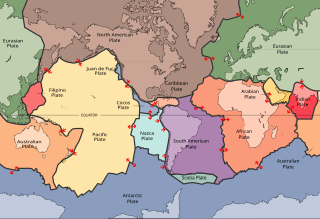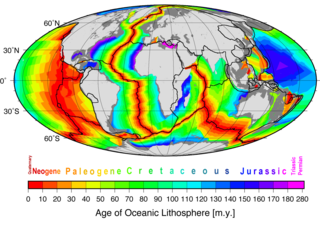Seafloor topography: cooling mantle and lithosphere models
The depth of the seafloor (or the height of a location on a mid-ocean ridge above a base-level) is closely correlated with its age (i.e. the age of the lithosphere at the point where depth is measured). Depth is measured to the top of the ocean crust, below any overlying sediment. The age-depth relation can be modeled by the cooling of a lithosphere plate [3] [6] [7] [8] [5] or mantle half-space in areas without significant subduction. [4] The distinction between the two approaches is that the plate model requires the base of the lithosphere to maintain a constant temperature over time and the cooling is of the plate above this lower boundary. The cooling mantle model, which was developed after the plate model, does not require that the lithosphere base is maintained at a constant and limiting temperature. The result of the cooling mantle model is that seafloor depth is predicted to be proportional to the square root of its age. [4]
Cooling mantle model (1974)
In the cooling mantle half-space model developed in 1974, [4] the seabed (top of crust) height is determined by the oceanic lithosphere and mantle temperature, due to thermal expansion. The simple result is that the ridge height or seabed depth is proportional to the square root of its age. [4] In all models, oceanic lithosphere is continuously formed at a constant rate at the mid-ocean ridges. The source of the lithosphere has a half-plane shape (x = 0, z < 0) and a constant temperature T1. Due to its continuous creation, the lithosphere at x > 0 is moving away from the ridge at a constant velocity , which is assumed large compared to other typical scales in the problem. The temperature at the upper boundary of the lithosphere (z = 0) is a constant T0 = 0. Thus at x = 0 the temperature is the Heaviside step function . The system is assumed to be at a quasi-steady state, so that the temperature distribution is constant in time, i.e.
Derivation of the mathematical model for a cooling mantle |
|---|
By calculating in the frame of reference of the moving lithosphere (velocity ), which has spatial coordinate and the heat equation is: where is the thermal diffusivity of the mantle lithosphere. Since T depends on x' and t only through the combination : Thus: It is assumed that is large compared to other scales in the problem; therefore the last term in the equation is neglected, giving one-dimensional diffusion equation: with the initial conditions The solution for is given by the error function:
Due to the large velocity, the temperature dependence on the horizontal direction is negligible, and the height at time t (i.e. of sea floor of age t) can be calculated by integrating the thermal expansion over z: where is the effective volumetric thermal expansion coefficient, and h0 is the mid-ocean ridge height (compared to some reference). The assumption that is relatively large is equivalent to the assumption that the thermal diffusivity is small compared to , where L is the ocean width (from mid-ocean ridges to continental shelf) and A is the age of the ocean basin. The effective thermal expansion coefficient is different from the usual thermal expansion coefficient due to isostasic effect of the change in water column height above the lithosphere as it expands or contracts. Both coefficients are related by: where is the rock density and is the density of water. |
By substituting the parameters by their rough estimates into the solution for the height of the ocean floor :
we have: [4]
where the height is in meters and time is in millions of years. To get the dependence on x, one must substitute t = x/ ~ Ax/L, where L is the distance between the ridge to the continental shelf (roughly half the ocean width), and A is the ocean basin age.
Rather than height of the ocean floor above a base or reference level , the depth of the seabed is of interest. Because (with measured from the ocean surface) we can find that:
- ; for the eastern Pacific for example, where is the depth at the ridge crest, typically 2500 m. [9]
Cooling plate model (1977)
The depth predicted by the square root of seafloor age found by the 1974 cooling mantle derivation [4] is too deep for seafloor older than 80 million years. [5] Depth is better explained by a cooling lithosphere plate model rather than the cooling mantle half-space. [5] The plate has a constant temperature at its base and spreading edge. Derivation of the cooling plate model also starts with the heat flow equation in one dimension as does the cooling mantle model. The difference is in requiring a thermal boundary at the base of a cooling plate. Analysis of depth versus age and depth versus square root of age data allowed Parsons and Sclater [5] to estimate model parameters (for the North Pacific):
- ~125 km for lithosphere thickness
- at base and young edge of plate
Assuming isostatic equilibrium everywhere beneath the cooling plate yields a revised age-depth relationship for older sea floor that is approximately correct for ages as young as 20 million years:
- meters
Thus older seafloor deepens more slowly than younger and in fact can be assumed almost constant at ~6400 m depth. Their plate model also allowed an expression for conductive heat flow, q(t) from the ocean floor, which is approximately constant at beyond 120 million years:
Parsons and Sclater concluded that some style of mantle convection must apply heat to the base of the plate everywhere to prevent cooling down below 125 km and lithosphere contraction (seafloor deepening) at older ages. [5] Morgan and Smith [10] [11] showed that the flattening of the older seafloor depth can be explained by flow in the asthenosphere below the lithosphere.
The age-depth-heat flow relationship continued to be studied with refinements in the physical parameters that define ocean lithospheric plates. [12] [13] [14]

















































